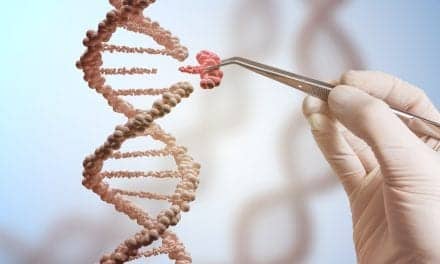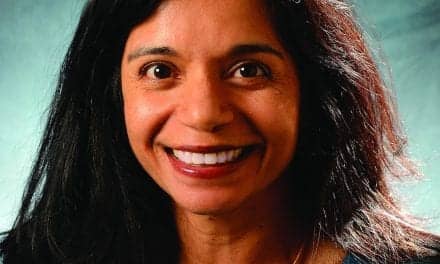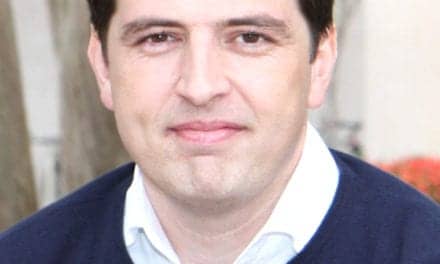 |
|
Scanning electron micrograph of the surface of the frog inner ear sensory epithelium showing the staircase-shaped stereocilia towering above other surface structures. Bar equals 1 µm. (Photo courtesy of C. Graydon and L. Andrade, NIDCD.) |
If the inner ear were a city, then stereocilia could be considered the flashy, high-rise buildings making up the skyline. Protruding from the tops of sensory cells, called hair cells, inside the inner ear, stereocilia are composed of long filaments of actin, a robust protein that also assists in muscle contraction, cell division, and other cellular activities. They are also the site at which sound vibrations entering the ear are converted into electrical signals that travel to the brain, so scientists want to know more about how stereocilia are constructed.
Researchers from the National Institute on Deafness and Other Communication Disorders (NIDCD), Washington, one of the National Institutes of Health, and others have now learned that two proteins that have been implicated in some forms of inherited deafness are responsible for building and maintaining these exquisitely formed structures. The research is published in Nature Cell Biology.
Stereocilia are arranged in tiered bundles, with one bundle topping each hair cell. Tiny filaments connect the shorter stereocilia to their taller neighbors so that, when stimulated by sound, the entire hair bundle moves as a unit. Moreover, each hair bundle is fine-tuned to respond to a specific sound frequency, with the length of its projections correlated to its preferred pitch. The lower the pitch, the longer the stereocilia need to be; the higher the pitch, the shorter the stereocilia.
In earlier studies, NIDCD scientist Bechara Kachar, MD, and others found that, throughout our lives, our stereociliia operate like constantly moving treadmills in which new actin is added to the tip of the filament and older actin is pushed downward until it reaches the bottom, at which point it can be recycled and added to the tip again. Exactly how the stereocilia are assembled remained unclear, however.
Using immunofluroescence techniques, Kachar and others in NIDCD’s Laboratory of Cell Structure and Dynamics, along with researchers at the University of Maryland, University of North Carolina, and University of California, Berkeley, found that myosin IIIa and espin 1 co-localize at the tips of the stereocilia. However, they noted that the two proteins were present in a more graded fashion along the length of the stereocilium, with the highest concentration at the tip. This indicated that the two proteins are continuously climbing from the bottom to the tip as opposed to being stationed there permanently.
When the researchers coaxed hair cells, as well as other non-sensory cells, to express more of the two proteins through the insertion of DNA, the filaments grew longer than they did when only one of the two proteins was added.
Based on these and other confirming biochemical and molecular biology techniques, the scientists concluded that myosin IIIa transports espin 1 from the base of the stereocilium to the tip, where espin 1 begins its task of adding more actin to the filament. Myosin IIIa is a “motor protein,” a protein that burns energy to move materials within cells. Although individual actin monomers—the bricks, so to speak—are smaller and can diffuse up the stereocilia on their own, espin 1— the machinery required to lay the bricks—is much larger and requires a lift to the top. Once the stereocilia reach their required height, the length is dynamically maintained.
Kachar likens the scenario to a home builder who suddenly decides to build a skyscraper instead. The builder would need a whole new set of tools and equipment to do that. So these two molecules, which are the products of genes whose mutations result in deafness, seem to be involved in the mechanism to build and maintain high-rises.
Kachar points out that, although a mutation in the gene that produces espin 1 results in hearing loss in newborns, mutations in the gene that produces myosin IIIa cause late-onset deafness, which can begin when a person reaches his or her 20s. This raises a new question: If myosin IIIa is so important to building and maintaining stereocilia, why isn’t the hearing loss immediate? His team is currently studying whether a similar myosin present in stereocilia—myosin IIIb—compensates for the lack of myosin IIIa before a person reaches early adulthood. These and other findings could enable researchers to consider new tools for replacing or compensating for defective proteins, thus opening up additional opportunities for the development of therapeutic strategies for hearing loss.
[Source: NIDCD]




